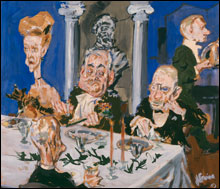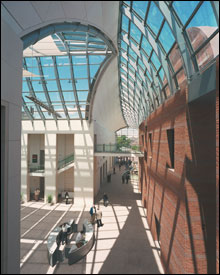When the Institute of Contemporary Art revealed specifics of the first 11 acquisitions for its permanent collection a month ago, I watched with particular interest. Greater Boston’s art institutions are in the midst of a building boom, and there’s been much talk of famous architects and raising money and how many bodies need to be crammed in for the institutions to break even. All very important stuff, but I keep wondering: what does all this new art infrastructure mean for the kind and amount of art we will see? Will our local cultural experience expand in direct proportion to all the shiny new square feet of exhibition space?
It’s a difficult question. The centerpiece of the Museum of Fine Arts’ expansion is a new four-story wing for its collection of art from the Americas, and there will be new galleries for temporary exhibitions and recent art from the permanent collection. The Isabella Stewart Gardner Museum is pondering a new building to create additional exhibition space. Harvard’s Fogg and Busch-Reisinger Museums, the DeCordova Museum in Lincoln, and Brandeis’s Rose Art Museum are planning or in the midst of renovations and/or expansions.

And this September, the Institute of Contemporary Art moves from Boylston Street into a flashy new glass box rising on Northern Avenue along the South Boston waterfront. It triples the museum’s size (from 20,000 square feet to 65,000 square feet) and exhibition space (6000 square feet to around 18,000 square feet) as well as adding administrative space and amenities. Inasmuch as the ICA was founded in 1936 to focus on the art of the now, it has avoided collecting art. (Lack of space would have made that difficult in any case.) But with the move, ICA leaders have decided to start. The announcement of the initial acquisitions is the first sign of where all this art building is leading us.
 To be a player — even a modest one — in the museum game generally requires you to organize shows with borrowed works and host traveling exhibits organized elsewhere. Katherine French took over as director of the Danforth Museum in Framingham at the start of 2005; soon after, she proposed modest changes to the former public high school that houses the 31-year-old institution. By November, when the Danforth opened its Joan Snyder painting retrospective, it had added a room devoted to children’s-book illustration, raised the ceilings a few feet, added some 45 feet of walls, and installed climate controls in the two galleries that housed the Snyder show.
To be a player — even a modest one — in the museum game generally requires you to organize shows with borrowed works and host traveling exhibits organized elsewhere. Katherine French took over as director of the Danforth Museum in Framingham at the start of 2005; soon after, she proposed modest changes to the former public high school that houses the 31-year-old institution. By November, when the Danforth opened its Joan Snyder painting retrospective, it had added a room devoted to children’s-book illustration, raised the ceilings a few feet, added some 45 feet of walls, and installed climate controls in the two galleries that housed the Snyder show.
Much contemporary art is big, and the Danforth’s changes helped it accommodate things like Snyder’s 12-by-6-foot canvases. But perhaps more important was the addition of climate controls to protect delicate pieces — like 30-year-old Snyder paintings. Speaking of the Hyman Bloom show the museum has scheduled for next year, French adds, “Most of the work belongs to collectors, and they would not have lent the work if it could not have been taken care of.”
These changes, she says, demonstrate that the museum is focusing on contemporary art, with plans to strengthen and highlight its holdings, particularly in the Jazz Age and the Depression era, and to build a collection of 20th-century Boston Expressionist work, artists like Bloom and Jack Levine, whom the Danforth exhibited last spring, work that’s seldom seen in local institutions. “I would like to be the museum where we tell the story of Boston Expressionism. It’s not the only thing that happened here, but it’s important for somebody to be telling that story.” French is hoping that the museum’s more ambitious stance will attract collectors and donors. It’s clear that the kind of changes the Danforth has made affect not only square footage but also the nature of a museum’s mission.
 In Salem, the Peabody Essex Museum opened a new wing and soaring glass-roofed atrium back in 2003. The project clarified an identity change that had been in motion before the construction began, turning the Peabody from a dusty collection of relics of the New England China trade, with all its colonial overtones, into a multicultural museum celebrating the art of this region as well as masterpieces by Asians, Africans, and Native Americans. The 207-year-old institution expanded its exhibition space from 140,000 to 250,000 square feet and doubled its room for temporary shows. The architecture itself showed the Peabody straddling old and new: Moshe Safdie’s modern design is complemented by the import of a breathtaking 200-year-old merchant house from southern China that the museum bills as “the only example of Chinese domestic architecture in the United States.”
In Salem, the Peabody Essex Museum opened a new wing and soaring glass-roofed atrium back in 2003. The project clarified an identity change that had been in motion before the construction began, turning the Peabody from a dusty collection of relics of the New England China trade, with all its colonial overtones, into a multicultural museum celebrating the art of this region as well as masterpieces by Asians, Africans, and Native Americans. The 207-year-old institution expanded its exhibition space from 140,000 to 250,000 square feet and doubled its room for temporary shows. The architecture itself showed the Peabody straddling old and new: Moshe Safdie’s modern design is complemented by the import of a breathtaking 200-year-old merchant house from southern China that the museum bills as “the only example of Chinese domestic architecture in the United States.”